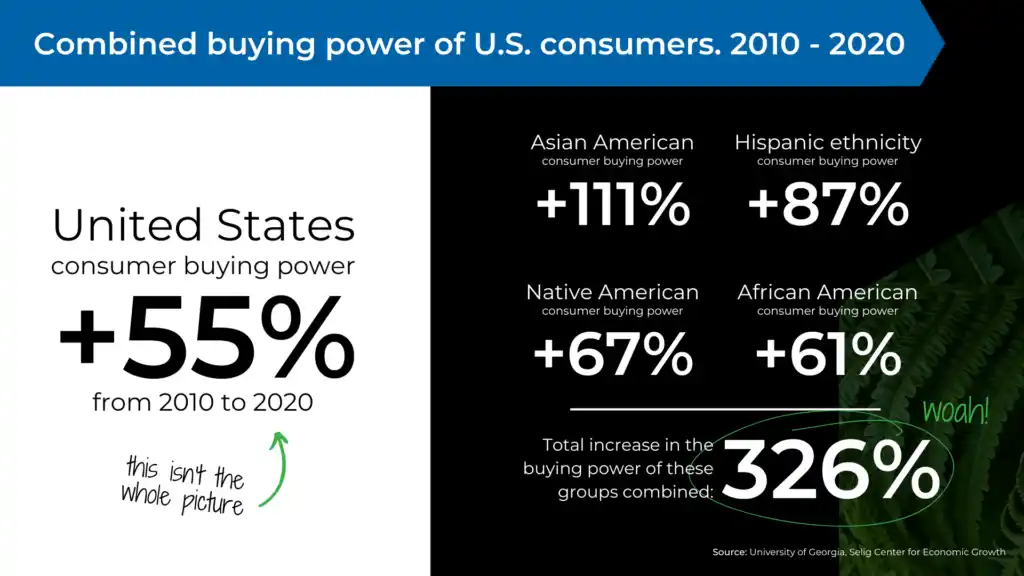
Nowadays, there’s more and more overlap between brand marketing and performance marketing. In case you’re rusty on the difference between those terms…
Brand marketing is what people immediately feel about your brand when they think of you. Brand marketing is a long term play that’s designed to grow a following. Its KPIs are awareness, influence, and market share.
Performance marketing is any activity that inspires someone to perform a certain action related to your brand. The obvious KPI here is units sold, but other ‘performances’ include whether the customer responds to upsells and cross-sells, becomes a repeat customer, or becomes an advocate who sends new business your way.
Optimizing this Brand-Performance marketing hybrid starts with keeping your head on a swivel. Here at Apiary, our swivel-watching has made it clear that true performance marketing MUST be inclusive marketing. We see zero distinction between these two terms.
In this Apiary POV on all things inclusive marketing, we’re sharing:
- What is inclusive marketing?
- The problem with targeting “everyone”
- MULTIPLE data points that prove ignoring inclusion is anti-growth
- Why is inclusive marketing important for B2B brands?
- Inclusive marketing examples (success stories + a few crash n’ burns)
- Our top 4 inclusive marketing strategy tips
- And! A refreshing inclusive marketing video interview with Apiary founder and chair, Karen Amundson.
What is inclusive marketing?
Simply put, inclusive marketing is marketing that considers diversity.
On the surface, the goal of inclusive marketing is to include representations of diverse groups who have historically been invisible in marketing campaigns.
Most people incorrectly assume that a brand can be defined as inclusive if their “real people” photography includes a diverse collection of skin colors. But this is actually a fairly narrow definition because:
- Race is not the only thing that diversifies people. Other points of difference include age, gender and sexual orientation, religious affiliation, mental health, ethnicity, disability, and more.
- Inclusive marketing starts with awareness of difference in your audience and then applies that understanding to the creation of targeting profiles, index selection, media types, content design, and copy/tone.
Beyond visual assets, the principles of inclusive marketing include creating marketing and ad copy that nods to diverse backgrounds, and refining the audience filters used in any social media or Google paid media efforts.
The problem with targeting “everyone”
“Who is the audience?” is one of the first questions that the best marketers ask.
Many brands shout, “Everyone!” in response to this question. Even brands focused on more niche audience groups tend to think that everyone within that category is their target and can be accessed in the same ways.
This “gen pop” assumption is inherently flawed, and why our digital marketing strategists never have and never will recommend gen pop targeting.
What is gen pop targeting?
Gen pop targeting seeks to drive engagement among what is presumed to be a mainstream audience that’s representative of the general population.
However, the inherent biases in gen pop marketing typically default to assuming that a white, cis-gender person is the baseline for the general population.
50/50 male/female targeting, with no other inclusions, tells algorithms that diverse audience acquisition isn’t your priority, but diverse audiences are the largest ones.
Bias doesn’t only exist in gen pop advertising collateral, but also in index data selections, campaign structures, and keyword efforts, which feed the algorithm and then create a self-fulfilling prophecy.
Gen pop targeting falls far short of rising diversity rates.
What gen pop campaigns focus on is problematic, to be sure. But our biggest beef is with what they leave out.
Gen pop campaigns ignore the largest and fastest growing customer segments.

Inclusive marketing done right drives customer expansion, which is the #1 goal of performance marketing. They’re the same thing.
An inclusive marketing strategy taps into enormous (and traditionally, overlooked) audience segments in a way that gen pop targeting isn’t equipped to.
By reaching more people, the size of your performance funnel increases from the awareness stage all the way through to higher conversion rates at acquisition. Brands that want more reach actually want inclusive marketing.
To relegate inclusive marketing to a fluffy CSR conservation is shortsighted. To make your business sustainable, the “tanning” of America must be actively woven into all marketing strategies.

Why is inclusive marketing important?
Most people assume that inclusive marketing strategies only apply to consumer marketing, but inclusion in B2B performance marketing is just as critical. Why?
Because the people making B2B buying decisions are also an increasingly diverse audience.
Let’s say your primary target is IT decision makers in the Fortune 1000. Those companies have made commitments to improve diversity in their hiring, so we can project that diversity among the top decision makers is only going to increase over time.
If you’re not thinking about inclusion in your B2B lead gen strategy, you’re leaving money on the table.
For example, one of our client-partners was a B2B brand who wanted to reach small business owners, but their team was unaware that the U.S. small business community is disproportionately female and women of color. They were mismanaging their resources by trying to market to “all small business owners” as if that audience is a homogenous mass.
B2B lead generation strategies that are clinging to this ‘gen pop’ approach to B2B marketing are running out of fumes. Fast.
The deeper levels of research and analysis inherent to inclusive marketing helps you understand your audience better, which then allows you to market to them more effectively.
Inclusive marketing examples
The “nude lipstick” inclusive marketing example…
In an episode of the Inclusion & Marketing Podcast, Apiary founder and chair, Karen Amundson shared several examples of inclusive marketing campaigns done right, and a few crash n’ burn stories, too.
Here’s one that particularly resonated with the podcast host and inclusive marketing strategist, Sonia Thompson:
Googling “nude lipstick” will produce results that are almost entirely skewed towards lighter-skinned audiences. Except “nude” doesn’t mean the same thing for all groups of people.
The brands that have invested in SEO performance and/or paid SEM in order to appear on the first page of SERPs for this term are therefore missing the opportunity to signal that their brand offers products for a wider variety of skin tones. This amounts to a brand kneecapping their own customer acquisition rates.
Another inclusive marketing example, from an Apiary client-partner:
A sunscreen brand came to us looking for paid media support, particularly with Meta. The client’s team happened to be made up of all white people. However, the Apiary team that we put together for them included people of color, and immediately, our more diverse group identified a value proposition that even the brand’s founders hadn’t considered.
This company produces a zinc-based sunscreen that doesn’t leave the smear of white residue that many non-toxic sunscreens are known for. Clearly, sunscreen that produces that icky ghost look is a pain point for everyone, but it’s a heightened pain point for darker-skinned people.
Seeing this obvious opportunity, we created a Meta strategy that intentionally focused on speaking to the audience with the biggest pain point and was therefore far more primed to purchase. Gen pop targeting would’ve missed that opportunity entirely.
Inclusive marketing strategy tips:
Established inclusive marketing best practices are still being formed as brands come to terms with changing demographics and consumer expectations.
However, the top 4 guiding principles that have shaped our organization and the highly successful inclusive marketing campaigns we’ve created for our client-partners are:
Tip #1: Diversify your team
Building a team that’s representative of the customers you want to reach gives you an automatic advantage over competitors with teams that are less diverse and inclusive.
Tip #2: Create a culture that constructively challenges its own marketing assumptions.
Add a step to your typical marketing strategy process that analyzes your current audience strategy, creative strategy, and/or testing strategy.
Normalize a strategic marketing development process that asks, “Who are we missing? Whose perspective have we omitted, whether intentionally or not?”
Tip #3: More specifically… Normalize talking about diversity stereotypes.
Having identified whose experience might be missing from your strategy, the next round of inquiry looks for any bias toward stereotypes about those missing perspectives.
Here at Apiary, we talk A LOT about team formation (considering life/work experience, lifestyle, race, gender, sexual orientation), and we frequently and openly examine how we can address and remedy any traps we may be falling into.
Considering bias in marketing once a quarter (or even less!) is part of what sustains the ethical and performance flaws of gen pop targeting. Normalize the topic so that it comes up more frequently, which in turn ideally increases your team’s awareness and comfort with the subject.
Tip #4: Collaborate with vendors with inclusive marketing experience.
Before hiring marketing teams, ask how they handle DE&I internally, and how they plan to advance your brand from an inclusive marketing standpoint.
Notice who they bring to the pitch. Who are the decision makers on their team that are driving your business strategy forward?
More and more RFPs include diversity or something hinting at inclusion, but it’s usually buried at the bottom or it’s otherwise clear that inclusion is an afterthought. Look for vendors that make inclusive marketing a pillar of their performance strategy.
TL;DR summary of inclusive marketing
- Inclusive marketing is a business strategy to acquire customers – not a one-off campaign initiative.
- Data shows that diversity rates in the U.S. are only increasing. Marketing that ignores this is leaving money on the table.
- Gen pop targeting is inherently exclusionary and antithetical to growth.
- Inclusive marketing is just as relevant for B2B brands as consumer brands.
- Build diverse teams and normalize the willingness to examine bias.




